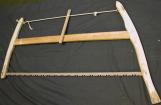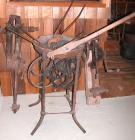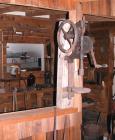14
BUCKSAW - Example of handtools used in local boat building.1930
Sunshine Coast Museum & Archives, Gibsons, British Columbia, Canada

15
Buck Saw -Hubert Evans used this saw to cut planks from timber. A scaffolding was made to hold the log and the saw would be used by two people. One person would work from the top of the log and the other person would work from below. The person on the bottom got the sawdust.
16
HAND FORGE Example of handtools used in local boat building. See story 'Tools' for more info.1909
Sunshine Coast Museum & Archives, Gibsons, British Columbia, Canada

17
Forging Metal Fittings -Charcoal can be a substitute for coal, and produces a much hotter fire than fir bark. It does require a bit of preparation, however. One way to make quantities of charcoal (and you need lots for forge work, compared to coal, which is denser) is to build a hot fire of stove-wood-size alder, maple or other hardwood in a pit in the ground, load it up with wood, then smother the fire with earth before it has had a chance to burn the pile down. Actually you don't smother it completely at first, but allow a very little air in through vent holes punched into the earth covering. The idea is to keep the combustion going but starved for sufficient oxygen. The gases burn off and the wood becomes carbonized. Once smoke ceases to exit the vents, these are closed off too, thus starving the fire of air altogether and effectively putting it out. When cold, the earth can be removed and the charcoal separated from the remaining dirt by means of a coarse seive. If kept dry, this is a decent fuel for a hot enough fire to weld iron if desired. There are more complicated ways to make charcoal of course, burning less wood in the process, but for backyard production this is effective.
18
BELLOWS - Example of handtools used in local boat building.1909
Sunshine Coast Museum & Archives, Gibsons, British Columbia, Canada

19
True "wrought iron" was used by choice for marine fittings, being more resistant to corrosion than the steels. Wrought iron is manufactured by an ancient process in which the product has a considerable amount of sulphur mixed with the iron. The sulphur probably contributes to the durability of the material around sea water. Remains of Viking craft and other Europeanships attest to the lasting qualities of wrought iron. Now, when "iron" fittings are made, usually of what is really mild steel, hot dip galvanizing in zinc or special zinc-rich paint coatings are usually used to protect the surface of the metal.
The bronzes and brasses (copper alloyed with silica, zinc, tin, manganese etc) can be cast or machined from solid and sheet stock to make boat fittings, but around these parts many of the boat fittings that might be made from these materials were common chandlery or mail-order items.
20
POST MOUNTED DRILL PRESS - Example of handtools used in local boat building.1909
Sunshine Coast Museum & Archives, Gibsons, British Columbia, Canada

21
Nicol Warn explains his setup -"I really don't have much to show in the way of a metal-working facility; a couple of hammers, vice grip pliers, a nothing-fancy vice, some hunky old chunks of iron for beating things on, and a forge made of a truck brake-drum set in the ground, with an electric stove-fan blowing air up through a grating (tuyere) in the center. Plus a cutting torch and buzz-box welder. And a post-mounted drill press like the one you have in the museum, except it's been modified to be run off a 3/4 HP electric motor. Add a hacksaw and cold-chisels and there are lots of things one can make from scrap metal."
22
ConclusionThe tools were simple but the results were extremely functional. The tools are a testimonial to the people who made them and used them.